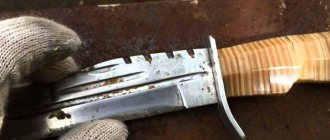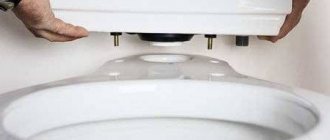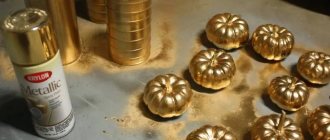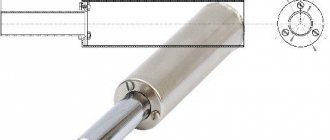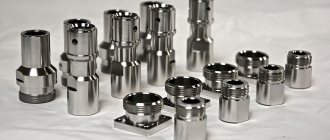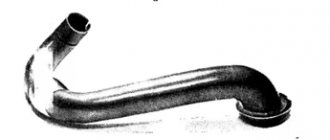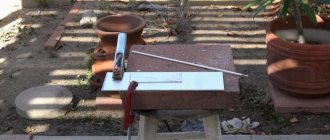Chrome plating is the application of a thin layer of chromium to a metal or plastic surface in order to give it a more attractive appearance, enhance the strength of the metal and increase its resistance to corrosion. However, with use, physical wear of the chrome coating occurs, which is why it loses its aesthetics, so many people think about how to remove chrome from plastic at home. Today, there are several main ways to do this, each of which involves the use of certain equipment, special solutions or other available means. Regardless of which method of removing chrome plating you choose, you must follow certain rules and precautions.
Removing chrome plating using specialized equipment
If you are looking for an answer to the question of how to remove chrome from plastic, then the easiest and most common way is to use specialized equipment.
In this case, there is no need to use various chemical solutions and come into contact with them, however, you must understand that such equipment is quite expensive. Such equipment includes:
- abrasive unit;
- ultrasonic cleaner.
Using an abrasive unit
An abrasive unit is equipment that uses special powder. Under the influence of high air pressure, this powder gradually erases the chrome coating. Similar installations can be found in specialized stores or at many enterprises whose activities are related to construction.
Depending on the thickness of the layer, a powder with a certain grain size is selected. When working with the installation, it is recommended to use face and respiratory protection, since small particles of chromium that enter the air are dangerous to human health.
Use of chemicals
If you are interested in how to remove chrome from plastic very quickly, then in this case you should resort to the help of special chemical solutions.
They are very powerful and effective and are capable of removing even the thickest and highest quality layer of chrome plating. However, when working with such products, you must be extremely careful and follow all safety precautions, since they are very toxic. Chemicals include:
- hydrochloric acid;
- sulfuric acid
- sodium hydroxide.
How to remove chrome from plastic using hydrochloric acid? You will need to make a 40 percent acid solution. To do this, dilute hydrochloric acid in water in a ratio of 1 to 3. Ready-made solutions are also available for sale, the instructions for which tell you how to remove chrome from plastic. "Mole" is one of such means.
The chrome-plated part is placed in a solution of hydrochloric acid until the chrome coating is completely removed, after which it is thoroughly washed under running water and soap and sent for drying.
The principle of using sulfuric acid to remove chrome plating is completely identical to that with hydrochloric acid.
“How to remove (remove) chromium from plastic using sodium hydroxide?” - you ask. In the same way as described above. However, there is one important nuance here. When working with this substance, contact with water and aluminum should be avoided, since when it reacts with them, sodium hydroxide releases toxic and flammable gas.
To prepare the solution, you will need a plastic container in which you need to mix 8 to 12 ounces of sodium hydroxide and add 3.8 liters of water. Next, the chrome plated part is placed in the solution until the spraying is completely behind. It’s worth noting right away that this can take quite a long period of time. After completing the removal process, the part is also washed thoroughly in clean water and soap.
Effective methods for removing rust from chrome surfaces
In everyday life, we often encounter the appearance of rust on various types of metal objects. Chrome-plated products, such as bathroom fixtures, are also susceptible to this problem.
Although there is an opinion that chrome plating is the most resistant to corrosion, this is far from the case. Under certain circumstances, when chrome is affected by several unfavorable factors at once, products may become covered with red spots.
In this article we will tell you how to remove rust from a chrome surface and how to avoid this problem in the future.
Chrome plating: concept and applications
Chrome plating is a special technology of applying a thin layer of chromium to metal products. Today, galvanic chrome plating is most often used. The process involves the deposition of chromium using an electrolytic solution onto a metal surface directly under the pressure of electrical charges.
The popularity of this operation is due to the fact that the chrome-plated part acquires improved technical and operational characteristics: strength, resistance to negative environmental factors. All this allows the metal to be used not only for finishing, but also for decorative purposes.
Chrome elements are widely used in mechanical engineering; electrical and plumbing equipment is created, which can be seen in almost every bathroom.
The disadvantages of this type of surface undoubtedly include low resistance to mechanical stress - small scratches, holes and chips appear on the coating quite quickly. If the material is used for external finishing work, then under the influence of oxygen (oxidation reaction) rust may also appear.
Causes of rusty plaque
The main cause of corrosion on the surface of chrome-plated products is excessive force and mechanical loads. They lead to the appearance of small scratches and cracking of the surface layer of the material. This happens as follows: the metal is covered with chromium, it oxidizes due to the negative influence of oxygen and other organic substances. This is how rust appears.
It is also worth noting that metal household appliances are constantly exposed to the aggressive effects of chemical reagents (soap suds, detergents, dust formations, mold). The feeling of cleanliness and comfort is lost - the coating becomes cloudy and loses its original natural shine.
Rust removers
Removing rust from metal surfaces can be done both with the help of specialized chemical compounds and with the use of folk remedies. It all depends on your personal preferences and financial capabilities.
Specialized compounds
Currently, the market offers a wide selection of compounds for effectively eliminating corrosion and rust stains. When choosing, you should be guided by the labeling, indicating the possibility of using the product specifically for cleansing. Among such products is WD-40.
To prevent the subsequent occurrence of this problem, it would be a good idea to use a protective polish for chrome. Professionals clean metal products with Doctor Wax and Autosol metal polish. Such polishing pastes help reduce wear on nickel-plated and other metal surfaces.
To clean chrome plating, you can also use multifunctional cleaning products, for example, Mister Muscle for plaque and rust.
On video: comparative test of polishes for chrome.
Available means
If you want to save on this process, then the means at hand will come to your aid. To combat corrosion you can use:
- toothpaste and an unnecessary piece of soft cloth;
- metal sponge (in advanced cases);
When removing rust from a nickel-plated surface yourself, it is important to use the appropriate material with which you will apply the cleaning agent. Experts recommend not using sandpaper, as it can cause new scratches.
How to clean chrome using folk remedies?
Since ancient times, our ancestors have faced the problem of rust on metal objects. Therefore, today there are many folk methods that will help remove rust from chrome surfaces. Before cleaning household appliances from rust stains using specialized compounds, try using the products described below.
Using Vinegar
Vinegar is considered the most effective anti-rust agent. Pour the solution into a plastic bag, then place the rusty parts in it for several hours. Small-sized items can be completely immersed in the solution, but large items will have to be attached to a bag using an elastic band or clothespin. After two to three hours, the corrosion stains will disappear, all that remains is to dry the surface and wipe with a clean cloth.
Lemon juice or Coca-Cola
Any liquids that contain acids will effectively dissolve rusty deposits. Similar to the first case, the chrome-plated part should be immersed in lemon juice or the surface of the product should be treated with a lemon slice. The well-known Coca-Cola is also suitable for the same purposes. If the corrosion spots are small, simply pour this drink on top and leave the part for a while.
Baking soda and sparkling water
Baking soda and sparkling water are great for fighting rust. They can be used instead of standard cleaning products. To remove the most stubborn stains, use metal wool - it removes corrosion well without damaging the rust-affected surface.
Fish fat
Fish oil will help prevent rust stains on chrome. Please note that this should be regular fish oil without any vitamin supplements. Using this product, gradually remove all traces of corrosion on the surface by applying grease at least twice to the affected areas. In this case, the mixture should remain on the coating for two weeks.
All methods and means (28 photos)
Source: https://GidPoKraske.ru/spetsialnye-materialy/diffuzionnoe-nasyshchenie/chem-ubrat-rzhavchinu-s-hromirovannoj-poverhnosti.html
Which method is not recommended?
Some experts recommend one piece of advice on how to quickly and efficiently remove chrome. It involves reversing the galvanization process. This method is very effective, but it is not recommended to use it yourself at home, since it is based on the use of electric current, and in the process of removing the binding of chromium elements to the metal, some very dangerous and toxic substances are released. Therefore, if you are looking for a way to remove chrome from plastic, then you should not experiment with this, but rather choose another method described above, or seek help from a qualified specialist.
Ultrasonic cleaning systems
This method is suitable for removing old worn chrome from metal and plastic. At the same time, ultrasound has a less destructive effect on plastic than high-pressure abrasive.
The principle of ultrasonic cleaning is based on the effect of ultrasonic waves on a chrome coating.
An element of the body or interior is immersed in a special container (bath), inside of which there is liquid. This can be plain water or a special solvent. The latter increases the efficiency of ultrasound and speeds up the coating removal process.
It is not advisable to purchase such a unit for personal use. Just like trying to assemble equipment with your own hands. But you can contact companies offering cleaning services in such ultrasonic baths. The price is relatively small, and the work is completed in the shortest possible time.
Removing a thin layer of chrome using improvised means
Before we talk about how to remove chrome from plastic using improvised means, it is immediately worth noting that the methods discussed below will only help in the case of a very thin layer of chrome plating, and in many cases they will be extremely ineffective. Most of these methods are based on the personal experiments of some innovators, so they may not be useful in your particular case. In most cases, they will help in removing fake chrome from plastic parts.
Removing chrome using improvised means
How can you remove chrome from plastic at home? An excellent option would be to use an abrasive. It can be made from ordinary baking soda or cleaning powder, which must be diluted a little with water to a paste-like state and then rubbed into the chrome coating until it begins to peel off. This method will only work if you are dealing with a very thin coating. When doing this, you should be very careful not to damage the base material.
Another chrome stripper that everyone probably has in their home is an aerosol stove cleaner. It has excellent degreasing properties, so it can help quickly remove light chrome plating from plastic. Such products are applied to the part for ten minutes, after which they are simply wiped off with a rag along with the coating itself. It is worth noting that some cleaners can have a negative effect on the base material, so it is recommended to remove chromium using them in several stages at short intervals. When working with household chemicals, be very careful and do not allow it to come into contact with your skin, eyes or respiratory tract.
How to remove chrome from plastic at home?
Hi all. Many of you have had to deal with such a nuisance... Chrome parts gradually lose their former luster over time and constant contact with the environment and, instead of emphasizing some features of the car, on the contrary, they make the appearance wretched or give away its age.
Given this feature, car owners quite often try to get rid of chrome by hiding it under film or paint in every possible way. However, in practice everything is not so simple. The film is short-lived and over time the chrome still breaks through from under the film, and the paint does not adhere well and, as a rule, peels off after several days, weeks or months.
Why isn’t it removed before covering it with a layer of paint or film, you ask? The fact is that chromium applied by galvanic chromium plating is very difficult to remove mechanically. And it’s bad, that’s not the right word, it can’t be removed at all... Sandpaper won’t take it, and working with a grinder is not always convenient, plus, you can remove the plastic layer along with the chrome, ruining the part.
In general, removing the chrome layer mechanically is another test...
How to be? In fact, there is a way out, and it’s quite simple and quick, it’s only important to know how, and to follow the safety rules. In this article I will tell you how and how to remove chrome from plastic quickly and efficiently, without making almost any effort.
First, a few words about what it is and how it is done... Chrome elements and parts are chrome plated by applying a galvanic layer, which is a mirror chrome coating. Chromium plating refers to an electrochemical process in which metal particles are applied to plastic.
It happens something like this: three metal layers are applied to the plastic: copper, nickel, and then chromium. The last layer interacts with nickel and lies evenly on the surface, completely covering it.
This type of chrome plating is used to apply chrome to various decorative parts, such as emblems, radiator grilles, moldings and other inserts that emphasize the gloss and status of the car.
How and with what to remove chrome from plastic?
Everything that cannot be removed mechanically can be removed chemically... It is chemistry that allows you to remove chrome without a trace without causing harm to the product. To work, you will need ferric chloride, which will do all the dirty and hard work for us.
What is ferric chloride?
Ferric chloride or ferric chloride (designated FeCl3 ) is an average salt of ferric iron and hydrochloric acid - as it is written on Wikipedia. This chemical composition appears as a soft, crystalline mass of reddish-brown, reaching almost black in color in places. In industry it is mainly used for etching printed circuit boards.
How to prepare a solution for removing chromium from plastic?
Now let’s talk about how to prepare a miracle composition that will help you get rid of chromium once and for all.
To make the magic composition you need to take one part of ferric chloride and mix it in three parts of hot water. During cooking, a reaction releases heat and steam, so you should “boil” it in a heat-resistant container, but not in a metal one.
Also take care to protect your hands and respiratory tract so that God forbid you do not harm yourself!!! Ferric chloride is poured into water in small portions, while the composition is constantly stirred. Stir gently until the mixture becomes homogeneous and there is no sediment in it.
In general, many pros recommend using a purified composition, which has been well settled for 5-7 hours, after which it has been filtered.
How to remove chrome at home?
After you have made the correct solution (it is advisable that its temperature be above 60 C°, this significantly speeds up the process of chromium removal), the parts to be treated are immersed in the composition and left in it for some time. It’s difficult to say which one, it all depends on many factors, such as: chromium layer, temperature of the composition, quality of ferric chloride, etc.
The process can be monitored by periodic checking; it should be checked no earlier than after 2-3 hours. The effect will be as follows: the part will completely get rid of chrome and will look white or black depending on what color of plastic you have. If you are satisfied with the result, you can stop the process at any time.
After carrying out all the work related to removing chrome, I recommend washing the parts using water and detergent. Further processing, be it water-print painting or film, is carried out as usual, without any differences.
In conclusion, I would like to add that all work must be carried out in a well-ventilated area in compliance with all safety regulations using gloves and a respirator. Careless handling of chemical composition may cause harm to you or your health. If the solution gets on your skin or, God forbid, in your eyes, wash it off with plenty of soap and water. If irritation or itching occurs, consult a doctor immediately.
Chrome bleaching
Another effective method is to soak the part to be desprayed in bleach. The part is completely immersed in the solution for approximately 24 hours. The removal process may take longer. It all depends on the thickness of the layer and the quality of the spraying. The advantage of using bleach is that it only affects the chrome plating without causing any harm to the base material. An important nuance: the bleach in which the chrome part was soaked must not be reused, since it will contain chromium, which is toxic to humans.
Removing chrome plating using brake fluid
The last method of removing a layer of chrome is perfect for car enthusiasts. Because it is based on the use of brake fluid. The thing is that it has a similar effect on light chrome plating as a solvent on paint, so brake fluid can help remove the chrome coating from a plastic part. However, it is immediately worth noting that this method cannot be called fast, since the process lasts several days.
The chrome part is wiped with brake fluid and left for 10 minutes, after which it is washed under running water. It is not recommended to leave the liquid on the part for a long time, since it can dissolve not only the chrome, but also the base material. Repeat this procedure until the chrome plating is completely removed.
What is chrome plating and how is it done?
To give surfaces a mirror-like metallic shine, the chrome plating method is used.
This is the application of a special galvanic layer to the car. The process is called galvanization or simply chrome plating.
This is a rather complex electrochemical process. When galvanizing, chromium (metal) particles are deposited on plastic or metal. Usually 3 sequentially applied layers are used:
- first comes the copper coating;
- then the part is coated with nickel;
- and at the final stage chromium is used.
Chromium interacts with nickel, which allows you to create a perfectly smooth surface after processing.
This method is relevant when decorating various plastic and metal elements of the machine:
- icons;
- emblems;
- inscriptions;
- radiator grilles;
- moldings;
- pens;
- inserts, etc.
Thus, the automaker or the car owner himself wants to improve the appearance of the car, make it brighter, more noticeable and beautiful.
Indeed, chrome parts visually enhance the status of the car. But you shouldn’t overuse chromium either. Then the car looks like a Christmas tree. Everywhere you need to know when to stop.
